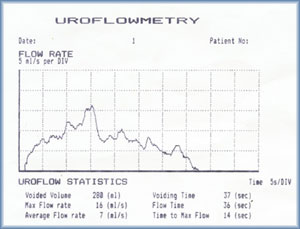| VOIDED VOLUME : |
| The reproducibility and reliability of the maximum flow rate is best with voided volumes between 200 ml & 400 ml. A reduced flow rate obtained at volumes smaller than 100 to 150 is unreliable in unobstructed cases the maximum flow rate will rise proportionally to the square root of the voided volume up to a volume determined by the bladder capacity. |
|
| FLOW TIME & VOIDING TIME : |
| In case with intermittent flow the voiding time & flow time will be different Post voiding dribble is often a non-pathological condition may be due to emptying of the urethra of urine by contraction of the bulb cavernous muscle or by manual procedures. |
|
| AVERAGE FLOW RATE : |
| Average flow rate is the voided volume divided by flow time. |
|
| MAXIMUM FLOW RATE : |
| The maximum flow rate is the most important single parameter in Uroflowmetry but interpretation of maximum flow rate values requires familiarity with the flow curve pattern the voided volume age and sex. In male patients a maximum flow rate exceeding 15 ml/sec. indicates normal bladder and urethral function [90 to 95 %] and maximum flow rate below 10ml/sec. are suggestive of intra-vesicle obstruction [90 to 95 %]. |
| |
 |
| |
| ACCEPTABLE MINIMUM URINE FLOW RATES |
| |
| AGE |
MIN. VOIDED VOLUME |
FLOW RATES |
|
| (Years) |
ml/sec. |
Males |
Females |
| 04-07 |
100 |
10 |
10 |
| 08-13 |
100 |
12 |
15 |
| 14-45 |
200 |
21 |
18 |
| 46-55 |
200 |
22 |
15 |
| 56-80 |
200 |
09 |
10 |
|
|
| |
| The maximum flow rate normally changes with age and young men in particular may be virtually obstructed with maximum flow rate about 15 ml/sec. so calls high flow high pressure intra-vesicle obstruction. In females 20ml/sec. is traditionally the arbitrary lower limit exists but in decreased urethral resistance due to bladder base insufficiency, extremely high flow rates may be encountered. |
|
| DELAY TIME (HESITANCY) |
| Delay time is the time interval between the existence of considerable urge to urinate & the beginning of the actual voiding. Delay time is usually less than 10 seconds in cases of intra-vesicle obstruction or in cases of psychological inhibition the delay time may be longer. |
|